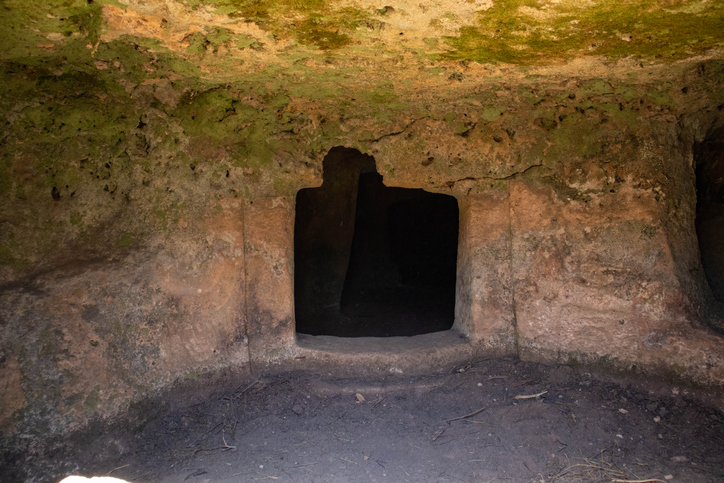The Necropolises in Sardinia: from north to south of the island the signs of an ancient civilisation.
A holiday in Sardinia, especially in the low season, does not just mean sea and nature, it also means immersing yourself in the traditions and thousand-year history of an area. There are many archaeological areas that can be visited, many are unique places in the entire Mediterranean area, necropolises of incredible beauty full of mystery and history.
Villaperuccio – Necropolis of Montessu
Located in the municipality of Villaperuccio, the Montessu necropolis is considered among the largest in the entire region. It is made up of 40 tombs which wind along rocky walls and in their arrangement seem to follow a very precise orientation towards east-west as if they were retracing the movement of the sun from dawn to dusk. According to scholars, the area was used by the various populations who inhabited Sardinia across the millennia, from the final Neolithic (3200-2800 BC) to the Ancient Bronze Age (1800-1600 BC). The Montessu park is also home to two imposing nuraghi and gigantic menhirs about five meters high, while throughout the territory there are various archaeological remains. The presence of the Domus de Janas is important, inside which funerary objects and frescoes celebrating the mother goddess and the bull god were found. Absolutely worth visiting are the so-called sanctuary tombs inside which the symbolism of spirals does not go unnoticed, an ancient symbol of life, death and rebirth. Also worth visiting is the tomb of the god Bull, so called for the horns carved on the walls and on the entrance step, or that of “sa Cresiedda" so called for its size and columns that recall Christian churches, or the “Tomba de is Proccus”.
Nurra – Necropolis Su Crucifissu Mannu
Located on the southern borders of the Porto Torres territory, the Sìu Crucifoissu Mannu necropolis is an archaeological treasure of inestimable value and beauty. The funerary complex was discovered in 1956 during the construction of the aqueduct and is made up of 22 tombs with an architectural plan divided into an antechamber, a cell and a series of rooms that open along the walls of the main cell. According to scholars, they date back to the Recent Neolithic, during the Ozieri Culture, between 3200 and 2800 BC. But the necropolis continued to be used until the Bronze Age, during the Bonnanaro Culture, between 1800 and 1500 BC. The finds recovered from the tombs relating to this phase are of considerable historical importance given that they anticipate the rise of the Nuragic civilisation. Among the many finds of notable interest are those relating to the funeral rituals of the time, such as the trepanned skulls, the practice of which is still a mystery.
Mores – Dolmen of Sa Coveccada
It is the largest in all of Sardinia: majestic and imposing, it is clearly visible from a distance. Its house shape is the symbol of the place where it was made. The Dolmen of Sa Coveccada is located about 5 kilometers south-east of the town of Mores and can be reached by taking the provincial road to Ittireddu-Bono. with a journey that takes the car just 400 meters from the tomb. However, due to its hidden location, it is advisable to obtain information on site. it is and is clearly visible from a distance: with its “house" shape still intact, it represents the symbol of Mores. Due to its particular characteristics, the monument is considered one of the most important and interesting examples of megalithic constructions in the Mediterranean. It has a rectangular layout with a hatch in the front. Made of tufaceous trachyte, it has a length of approximately 5 meters, a width of 2.50 meters and a height of 2.70 meters. The internal chamber has a rectangular shape, is just over 4 meters long and about one meter wide. The chamber is delimited by two large lateral boulders and the tomb is closed with a flat covering slab called “coveccada" in the Logudorese dialect, which means “blanket". Inside there are niches for offerings, an element which confirms that ceremonies and rituals were held inside.
Alghero – Anghelu Ruju Necropolis
It was discovered almost by chance in 1903 and has been the subject of numerous excavation campaigns over the years which have brought to light 38 Domus de janas. The necropolis of Anghelu Ruju is considered among the most important prehistoric sepulchral evidence in all of northern Sardinia and, in fact, hosts one of the largest prehistoric cemeteries on the island. It is located approximately ten kilometers from the sea in the hinterland of Alghero, not too far from the Filibertu river. The 38 tombs discovered to date, according to scholars, were used by different cultures ranging from the Late Neolithic to the early Bronze Age. In some of these you can admire bas-reliefs, engravings and symbols dating back to the Mediterranean Neolithic and Eneolithic. Numerous finds recovered during the various excavation campaigns completed in 1967 are currently available

